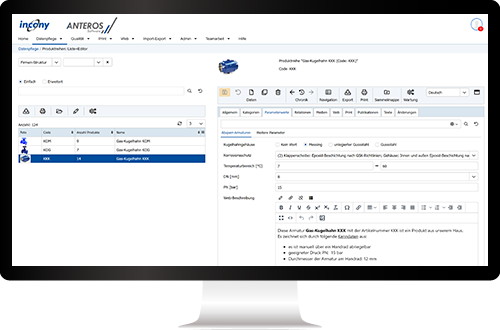Digital Product Passport (DPP): Product Transparency and Sustainability
The growing demand for transparency and sustainability in the product industry has led to the creation of the Digital Product Passport (DPP). It provides a comprehensive digital identity for products and access to critical information about their origin, production and environmental impact.
This article provides key information about the DPP: What is the DPP, what are its benefits and how is it implemented?
What is the Digital Product Passport?
The digital product passport (DPP) is a standardized compilation of information on product components, materials, chemicals, repairs, spare parts and disposal in a shared document. It can therefore be considered the digital twin of the physical product.
What Does the DPP Aim to Achieve and Require?
The DPP makes data from all stages of the lifecycle - from development through use to disposal - easily available and aims to
- increase transparency
- promote the circular economy
- improve resource efficiency
- support compliance with legal requirements
The Digital Product Passport (DPP) is accessed via a unique identifier, such as a QR code or an RFID identifier. This can be on the product itself or on the packaging.
The DPP needs to be updated regularly. This can be done either manually or automatically based on predefined data structures. The stored data is converted into a user-friendly format, which can include different representations:
- Visual representations: Charts, graphs and symbols
- Summaries: Sustainability ratings, recycling instructions
- QR codes or digital markers: Link to the full DPP online
The Digital Product Passport requirements apply to the 27 EU countries.
The introduction of the Digital Product Passport is in response to several key concerns in today's economic and environmental climate:
Growing demands for sustainability: more and more people are recognizing the negative impact of consumption on the environment and are looking for more sustainable alternatives. Furthermore, regulations such as the EU Green Deal and the ESPR (Ecodesign for Sustainable Products Regulation) require companies to be more transparent and environmentally responsible.
Lack of a circular economy: Currently, the economy largely operates in a linear fashion, where resources are extracted, utilized and disposed of without any particular focus on reuse or recycling. By tracking materials and components over the entire product life cycle, the DPP enables sustainable working and thus contributes to the establishment of a circular economy.
Opaque supply chains: Tracking products can be a challenge due to complex and globalized supply chains. By introducing this transparency, companies can take responsibility and optimize their processes in terms of sustainability.
Need for efficiency: The lack of digitalization of product information makes communication along the supply chain difficult. This leads to lengthy processes, high administrative costs and inefficient workflows.
Compliance with legal regulations: Companies are confronted with a growing number of regulations relating to product information, environmental impact and recycling.
Who Benefits from the Digital Product Passport?
The digital product passport provides numerous benefits for various players along the entire value chain, from production to retail to the end consumer. The specific benefits for the stakeholders depend on the industry in question.
| | | | |
The Digital Product Passport presents a number of challenges for companies. Ensuring data quality is particularly important, as inaccurate or inconsistent information can undermine confidence in the DPP. Access control also needs to be well thought out to protect sensitive data and ensure that only authorised users can access the data.
Measures such as encryption and anonymization play a central role in data protection. To minimize risk and ensure that the DPP complies with privacy regulations, only the most necessary data is collected. In addition, data security is further enhanced through auditability and regular security checks, while training reduces human error.
Other challenges include the lack of standardization and interoperability between different systems, which makes it difficult to share data, and the high cost of implementation, which is a barrier for smaller companies in particular. To ensure the success of the DPP, consumer confidence must also be strengthened through transparent communication and education.
Benefof the Digital Product Passport
The DPP offers a number of benefits that are important for businesses, consumers and the environment:
1. Transparency: The DPP provides a clear overview of product information, such as origin, materials used and production methods. This transparency boosts consumer confidence as they can make informed purchasing decisions based on verified information. 2. Sustainability: The DPP makes it easier to disclose information about a product's recyclability, reusability and carbon footprint. This supports efforts towards a greener economy and promotes the circular economy through more efficient use of resources. 3. Traceability: The DPP improves the traceability of a product throughout the supply chain. Companies can better document the origin of raw materials, production processes, and even the whereabouts after use, which is especially beneficial in the event of a recall or quality control. | 4. Increased efficiency: The DPP helps companies to streamline internal processes by providing access to comprehensive data along the production chain. This helps to identify bottlenecks and use resources more efficiently, leading to a reduction in costs and material consumption. 5. Competitive advantage: Companies that value transparency and sustainability can set themselves apart from the competition by using the DPP. This not only strengthens the brand image, but also meets the increasing expectations of consumers and regulatory authorities for ethical business practices. 6. Compliance: The DPP simplifies regulatory compliance by providing all relevant data in a structured and centralized manner. This makes it easier for companies to demonstrate compliance with environmental and safety standards and minimize legal risks. |
PIM and the Digital Product Passport
A Product Information Management (PIM) system plays a central role in the creation and management of the Digital Product Passport, acting as a single point of truth. PIM systems allow all product information to be centralized in one place, creating a reliable and consistent database for the DPP. This central data source ensures that all relevant information is easily accessible and forms the basis of the DPP.
Standardizing data in a PIM system ensures that product information is consistent and accurate across platforms. This is critical to creating a trusted DPP as it minimizes errors and increases the reliability of the information. Furthermore, PIM systems foster a collaborative environment where different departments can work together to update and maintain product data, making data exchange much easier for the DPP.
Using a PIM system to create a Digital Product Passport (DPP) has a number of benefits that make the entire process more efficient and accurate.

Benefits of a PIM system for the DPP:
Reduced complexity: Leverage existing product data, saving time and effort
Improved accuracy: Consistent and standardized data minimizes errors and ensures reliable DPP information
Easier updates: Changes in the PIM are automatically propagated to the DPP, reducing maintenance overhead.
Rationalized workflows: PIM workflows and approvals streamline DPP creation and management
Take advantage of the ANTEROS PIM system for your DPP!
Increase the efficiency and accuracy of your product data management, simplify workflows, and provide consistent, accurate information - all from a single source. Find out how a PIM system can help your company create a reliable product passport and book a free online demo!






